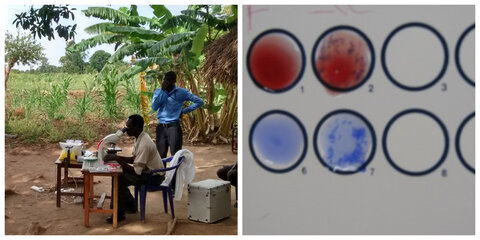Recent study: Gambian human African trypanosomiasis in North West Uganda. Are we on course for the 2020 target?

LSTM’s Dr Richard Selby and Dr Charles Wamboga from the Ministry of Health (MoH) in Uganda are the lead authors on a study of Gambian sleeping sickness prevalence in historical foci of north west Uganda, the work has been published in PLOS NTD . This work was a collaborative study between LSTM, the Ugandan MoH, the Co-ordinating Office for Control of Trypanosomiasis in Uganda (COCTU) and Institute de Recherche pour le Développement (IRD) in France.
Sleeping sickness surveillance in the area has switched from active to passive screening, this study was conducted in 2015, four years after the last active survey. The area has also seen the introduction of vector control with the deployment of insecticide-treated Tiny Targets along rivers which support the riverine habitat of the tsetse fly. The results of the work demonstrate that Uganda is on course to meet WHO’s 2020 elimination target.
Gambian sleeping sickness, caused by Trypanosoma brucei gambiense, is a chronic infection, a person can be infected for months or even years without showing distinguishable symptoms of the disease. Without treatment the disease is considered fatal. Riverine species of tsetse flies are responsible for transmission of the disease which is generally considered to be anthroponotic. The disease has been targeted for elimination by 2020 defined as: total area at risk reporting ≤1 case per 10,000 people per year and a global burden of less than 2,000 cases per year, at a country-level the goal is <1 case per 10,000 people per year per health district.
In Uganda, the number of cases of Gambian sleeping sickness has been declining from 1,469 cases in 1994 to just 9 cases in 2014. This decrease is the result of large scale active and passive screening programmes by the Uganda National Sleeping Sickness Programme, Ministry of Health, WHO and Médecins Sans Frontières France and Spain. Prior to this study, the last large-scale active screening was in 2010-2011 where over 74,000 people were screened, and 22 cases were identified. Since then all cases have been identified through the passive system at health facilities. To contribute to the elimination effort, LSTM and COCTU introduced tsetse control using Tiny Targets in 2011 and subsequently scaled up this initiative in 2014.
To evaluate the status of Gambian sleeping sickness in areas where Tiny Targets have been deployed, the team of researchers conducted an active screening survey in the historical foci of Arua, Maracha, Koboko and Yumbe. Tiny Targets have been used in Arua and Maracha since 2011, while in Koboko and Yumbe they were introduced in 2014. In total they screened 10,963 volunteers in 28 villages using Card Agglutination Trypanosomiasis Tests (CATT).
Ninety-seven people were identified as suspect cases and were screened further and examined microscopically for confirmation where all were revealed to be negative. All 97 were given appointments for follow-up after three months, 79 of the 97 presented for their appointments and all were negative. The 97 participants also provided a sample for further analysis using the immunological trypanolysis test. Interestingly, the trypanolysis showed three participants had immunological evidence of T. b. gambiense infection. Two of the three were former sleeping sickness patients who had been treated >10 years ago, while the third had no sleeping sickness case history. These findings throw up some interesting questions which are discussed by the authors.
With the absence of confirmed cases in the screening study the authors demonstrate that the move from active screening to enhanced passive screening in Uganda has been successful. The authors recommend that enhanced passive screening should form the basis for control in areas where prevalence is low. Sampling coverage turnout was ~72% which is considered satisfactory, but it does highlight the difficulties of relying on screening alone. This is particularly pertinent in areas that are hard to reach and considering a large proportion of the population that do not attend screening are likely to be people engaged in subsistence activities which potentially bring them into contact with tsetse. The addition of tsetse control to screening reduces the risk of undiagnosed infected individuals getting bitten and the parasite subsequently being transmitted.
Dr Selby concludes “The major outcome of this study is the validation that a large area of Uganda that has historically been blighted by HAT is currently within the elimination threshold, however a secondary finding from trypanolysis specifically finding a positive from a person with no HAT history exemplifies the risk of the disease laying undetected. A danger that has been mitigated through combining ongoing passive screening efforts with Tiny Targets based tsetse control to prevent transmission.”
Selby R, Wamboga C, Erphas O, Mugenyi A, Jamonneau V, Waiswa C, Torr SJ, Lehane M (2019) Gambian human African trypanosomiasis in North West Uganda. Are we on course for the 2020 target? PLoS Negl Trop Dis 13(8): e0007550. https://doi.org/10.1371/journal.pntd.0007550